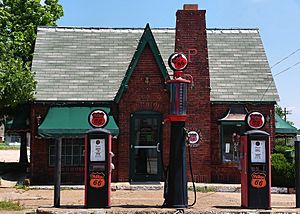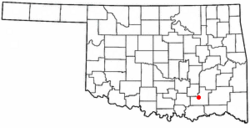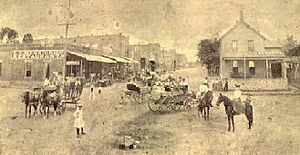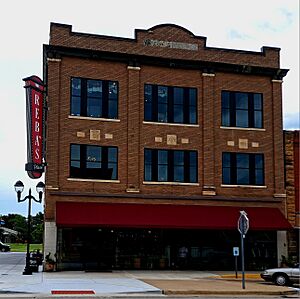Atoka, Oklahoma facts for kids
Quick facts for kids
Atoka, Oklahoma
|
|
|---|---|

The Atoka County Chamber of Commerce Building in Atoka.
|
|
| Motto(s):
"A City Committed to the Future"
|
|

Location of Atoka, Oklahoma
|
|
| Country | United States |
| State | Oklahoma |
| County | Atoka |
| Area | |
| • Total | 8.40 sq mi (21.75 km2) |
| • Land | 8.23 sq mi (21.31 km2) |
| • Water | 0.17 sq mi (0.44 km2) |
| Elevation | 583 ft (177 m) |
| Population
(2020)
|
|
| • Total | 3,195 |
| • Density | 388.40/sq mi (149.96/km2) |
| Time zone | UTC-6 (CST) |
| • Summer (DST) | UTC-5 (CDT) |
| ZIP codes |
74525, 74542
|
| Area code(s) | 580 |
| FIPS code | 40-03300 |
| GNIS feature ID | 1089746 |
Atoka is a city in Oklahoma, United States. It is the main city, or county seat, of Atoka County. In 2020, about 3,195 people lived there.
The city was first settled by the Choctaw people. It was named in 1867 by a missionary for Chief Atoka. His name means "ball ground" in the Choctaw language.
Contents
History
Atoka was founded by the Choctaw Indians in the 1850s. It was named after Captain Atoka, an important leader of the Choctaw Nation. He signed the Treaty of Dancing Rabbit Creek, which moved the Choctaw people from Mississippi to Oklahoma in 1830. The name "Atoka" comes from a Choctaw word meaning "ball ground."
Atoka is home to the oldest Catholic church in the area once known as the Indian Territory. It also has the oldest chapters of the Freemasons and the Order of the Eastern Star in Oklahoma.
Battle of Middle Boggy Depot
A small battle during the Civil War happened north of Atoka on February 13, 1864. A Union Army group, led by Colonel William A. Philips, moved through Confederate-controlled Indian Territory. Their goal was to weaken the Confederate hold and gain support from Native American tribes.
About 350 Union soldiers advanced towards Boggy Depot, a Confederate supply base. On their way, they met a small Confederate camp of about 90 soldiers by the Middle Boggy River. In the fight, 47 Confederate soldiers died. There were no Union deaths.
The Atoka Museum, which used to be the Confederate Museum, remembers this battle.
Founding of the City
Even though Choctaw people lived in the area since the 1830s, the city of Atoka was officially founded in 1867. A Baptist missionary named J.S. Murrow started it. Atoka quickly became the main city in the region, taking over from the nearby town of Boggy Depot.
A big reason for Atoka's early growth was the MKT Railroad. It arrived in 1872 and brought economic life to the town. Many businesses moved to Atoka from Boggy Depot because of the railroad.
Also in 1872, Father Michael Smyth started St. Patrick's Catholic Church. This was the first Roman Catholic church in what would become Oklahoma. Later, in 1875, the Sacred Heart Mission was founded in Atoka by Benedictine monks. This mission later moved and became St. Gregory's University.
Around 1896, Robert L. Williams moved to Atoka. He later became the third Governor of Oklahoma and the first Chief Justice of the Oklahoma Supreme Court.
Recent Developments
Atoka is located where two major highways meet: U.S. 69 and U.S. 75. This is a great spot for transportation. The city is working hard to attract new businesses and people. It aims to create more good jobs.
Economic growth has been moving north from Dallas, Texas, along U.S. 75. Towns south of Atoka, like Durant, Oklahoma and Sherman, Texas, are growing a lot. If this growth continues, Atoka could see similar expansion.
In 2023, famous country music star Reba McEntire teamed up with the Choctaw Nation and the city. They opened a restaurant called Reba's Place in downtown Atoka. This restaurant has brought more visitors to the area and is helping the local economy grow.
Historic Places
Many important historical sites in Atoka County are located in the city of Atoka. These sites are listed on the National Register of Historic Places (NRHP), meaning they are officially recognized for their historical value.
- Atoka Armory
- Boggy Depot Site
- First Methodist Church Building
- Indian Citizen Building
- Masonic Temple
- Middle Boggy Battlefield Site and Confederate Cemetery
- Old Atoka County Courthouse
- Old Atoka State Bank
- Pioneer Club
- Joe Ralls House
- Captain James S. Standley House
- Zweigel Hardware Store Building
Geography
Atoka is located at 34°23′3″N 96°7′39″W / 34.38417°N 96.12750°W. The city covers a total area of about 8.4 square miles (21.75 square kilometers). Most of this area is land, with a small part being water.
Demographics
| Historical population | |||
|---|---|---|---|
| Census | Pop. | %± | |
| 1910 | 1,968 | — | |
| 1920 | 2,038 | 3.6% | |
| 1930 | 1,856 | −8.9% | |
| 1940 | 2,548 | 37.3% | |
| 1950 | 2,653 | 4.1% | |
| 1960 | 2,877 | 8.4% | |
| 1970 | 3,346 | 16.3% | |
| 1980 | 3,409 | 1.9% | |
| 1990 | 3,298 | −3.3% | |
| 2000 | 2,988 | −9.4% | |
| 2010 | 3,107 | 4.0% | |
| 2020 | 3,195 | 2.8% | |
| U.S. Decennial Census | |||
In 2010, there were 3,107 people living in Atoka. The population density was about 355 people per square mile. The median age in the city was 41 years old.
Economy
In the 1800s, Atoka's economy was based on wood products. There were many hardwood trees nearby and enough water from the Boggy River to power sawmills. The railroad helped ship these products.
In the early 1900s, Atoka became a community focused on ranching and farming. Today, local leaders are working to bring new industrial jobs to Atoka. There are industrial parks available for new businesses.
In 2006, the city's largest employer, Ethan Allen Furniture, closed its plant in Atoka. This meant over two hundred people lost their jobs. However, in 2007, Ethan Allen reopened the plant as a distribution center.
Besides local businesses, Atoka is also popular for hunting and fishing. Tourism, especially with new attractions like Reba's Place, is also becoming more important to the city's economy.
Transportation
Four highways meet in Atoka: U.S. Route 69, State Highway 3, State Highway 7, and U.S. Highway 75. This makes it an easy stop for travelers. U.S. 69 and U.S. 75 join together here, heading south.
The Atoka Municipal Airport is located just northwest of town. It has a paved runway for small planes.
For larger commercial flights, Atoka is about the same distance from Dallas/Fort Worth International Airport, Will Rogers World Airport in Oklahoma City, and Tulsa International Airport.
Media
Atoka has several local media options. The Atoka County Times is a weekly newspaper. There is also a radio station, 102.1 KHKC. Television stations KXII and KTEN broadcast from Sherman, Texas.
A popular local radio show called Tradio is broadcast every weekday morning. On the show, callers advertise items like cars or furniture, or events like auctions and garage sales.
Education
Most of Atoka is part of the Atoka Public Schools System. A small part of the city is in the Tushka Public Schools district.
The Atoka school district serves students from all over Atoka County. It offers many academic and extra-curricular activities, including football, track, and robotics.
Atoka High School
Atoka High School is located on the west side of town. It usually has between 300 and 400 students in grades 9 to 12. Besides regular classes, the high school offers Spanish, Choir, Agricultural Education (FFA), and Drama. The Mock Trial team has won the Oklahoma state competition six times. The school also has many sports teams, including baseball, softball, football, and golf. A new cafeteria opened in 2007, making the high school a closed campus.
Junior High and Elementary Education
C.A. "Barney" McCall Junior High School is located south of the high school. It has about 200 to 250 students. The Atoka Elementary School is north of the high school. All three schools are now located close together.
Higher Education
Atoka is also served by Kiamichi Technology Center. The Atoka campus offers courses in Business Information Technology, Computer Repair & Networking, Cosmetology, Child Care, Nursing, Auto Mechanics, and Carpentry.
Notable people
- Jim Barnes, Oklahoma Poet Laureate
- Todd Downing (writer), novelist
- Lane Frost, professional bull rider
- Lowell Fulson, blues musician
- Charles McCall, Speaker of the Oklahoma State House of Representatives
- Reba McEntire, country music artist
- J. Vernon McGee, radio minister
- Matthew Mungle, Academy Award-winning makeup artist
- Crystal Robinson, WNBA player
- U. L. Washington, former MLB player
See also
 In Spanish: Atoka (Oklahoma) para niños
In Spanish: Atoka (Oklahoma) para niños



